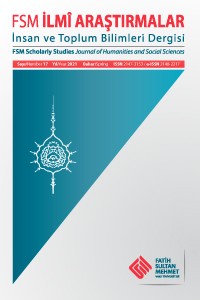Haydarpaşa’da Gün Işığına Çıkarılan Abdülmecid Han Çeşmesi ve Sarnıcı ile Halid Ağa Çeşmesi Kitâbesi
Öz
1839 yılında Sultan Abdülmecid’in ihya ettiği Halid Ağa Çeşmesi’nin adı değiştirilerek
Abdülmecid Han Çeşmesi olmuştur. 1902 senesinde günümüzdeki Haydarpaşa’daki yerine
taşınmış ve çeşme zamanla yol kotu altında kalmıştır. Haydarpaşa Tren İstasyonu
alanında, “Marmaray Projesi Gebze-Halkalı Banliyö Hattı İyileştirmesi” kapsamında,
İstanbul Arkeoloji Müzeleri denetiminde 2018 senesinde “Haydarpaşa Garı Arkeolojik
Kazıları” başlatılmıştır. Kazı çalışmaları sırasında çeşmenin taşınmadan evvelki yerinden
Halid Ağa Çeşmesi Kitâbesi bulunmuştur. Tıbbiye Köprüsü G1 ayağının inşası sırasında
ise Haydarpaşa’daki mevcut yerinden Abdülmecid Han Çeşmesi ve Sarnıcı ortaya çıkarılmıştır.
Tüm bu çalışmalar sayesinde gün ışığına çıkarılan bu eserler kültürel bir miras
olarak kentsel dokuya tekrar kazandırılmıştır. Bu çalışmanın literatüre katkısı, çeşmenin
yapım tarihinden günümüze kadar geçirdiği tüm değişimlerin belge ve haritalarla tespit
edilmesidir. Çeşme, çağdaş örnekleri ile süsleme detayları açısından karşılaştırılmış, ölçü ve yapısal özellikleri tanımlanarak araştırmacılara veri oluşturmuştur. Zamanla işlevini
kaybeden çeşmenin yeniden ortaya çıkarılması ile koruma sorunları değerlendirilmiştir.
Anahtar Kelimeler
Kaynakça
- Akbulut, M. Rıfat, “Haydarpaşa”, Dünden Bugüne İstanbul Ansiklopedisi, cilt 1, İstanbul, Türkiye Ekonomik ve Toplumsal Tarih Vakfı, 2003.
- Aksoy, Hasan, “Zîver Paşa”, İslâm Ansiklopedisi, cilt 44, İstanbul, Türkiye Diyanet Vakfı Yayınları, 2013.
- Altındağ, Ülkü, “Dârüssaâde”, İslâm Ansiklopedisi, cilt 9, İstanbul, Türkiye Diyanet Vakfı Yayınları, 1994.
Abdülmecid Han Fountain and Cistern and the Inscription of the Halid Ağa Fountain, Unearthed in Haydarpasha
Öz
In 1839, the name of the Halid Ağa Fountain, which was restored by Sultan Abdülmecid,
was changed into Abdülmecid Han Fountain. It was moved to its current location
in Haydarpasha in 1902 and over the time the fountain remained below the road level .
In the area of Haydarpaşa Train Station, “Haydarpasha Train Station Archaeological Excavations”
was started in 2018 under the supervision of Istanbul Archeology Museums,
within the scope of “Marmaray Project Gebze-Halkalı Suburban Line Improvement”.
During the excavations, the Halid Ağa Fountain Inscription was found in the place before
the fountain was moved. During the construction of the Tıbbiye Bridge G1 pillar, Abdülmecid
Han Fountain and Cistern were unearthed from its current location in Haydarpaşa.
Thanks to all these works, which were brought to light, were brought back to the urban
fabric as a cultural heritage. The contribution of this study to the literature is to identify
all the changes that the fountain has undergone from the date of its construction to the present
day, with documents and maps. The fountain was compared with its contemporary
examples in terms of ornamental details, its size, and the structural features were defined
and data were created for researchers. Conservation problems were evaluated with the
re-discovery of the fountain, which lost its function over time.
Anahtar Kelimeler
Kaynakça
- Akbulut, M. Rıfat, “Haydarpaşa”, Dünden Bugüne İstanbul Ansiklopedisi, cilt 1, İstanbul, Türkiye Ekonomik ve Toplumsal Tarih Vakfı, 2003.
- Aksoy, Hasan, “Zîver Paşa”, İslâm Ansiklopedisi, cilt 44, İstanbul, Türkiye Diyanet Vakfı Yayınları, 2013.
- Altındağ, Ülkü, “Dârüssaâde”, İslâm Ansiklopedisi, cilt 9, İstanbul, Türkiye Diyanet Vakfı Yayınları, 1994.
Ayrıntılar
| Birincil Dil | Türkçe |
|---|---|
| Bölüm | Araştırmalar ve İncelemeler |
| Yazarlar | |
| Yayımlanma Tarihi | 24 Haziran 2021 |
| Kabul Tarihi | 2 Haziran 2021 |
| Yayımlandığı Sayı | Yıl 2021 Sayı: 17 |


